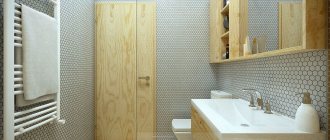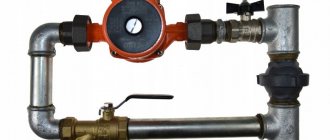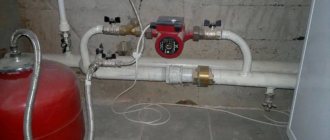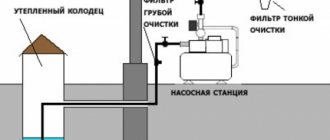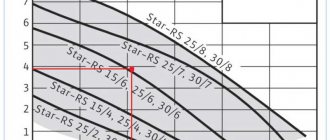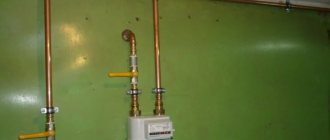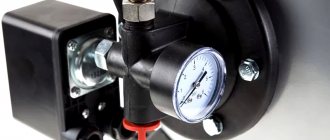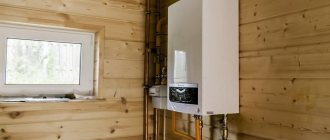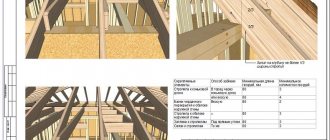It is not often possible to organize the inclusion of a private house, summer house or cottage in the centralized water supply system. Usually their owners have to decide on an autonomous water supply system for their home.
But, even if it is possible to connect to a city or village water supply running next to the house, having an independent source of water on the site is not a bad idea, both from an economic point of view, for example, using it for irrigation, and as a guarantee against sudden central system shutdowns.
general information
The autonomous water supply system of a private house consists of several components:
- water source:
- A well is an artificial excavation-mine dug to collect underground groundwater in the surface aquifer to a depth of 10~15 m and reinforced against collapse.
- Wells . They are carried out by drilling and come in several types: Gravity : “on sand” - up to 50 m, “on limestone” - up to 150 m.
- Artesian - over 150 m.
- Abyssinian and others.
- Water consumers on site and in the house : sinks, sinks, baths, saunas, swimming pools, irrigation.
- Supply and distribution system : pumps, storage tanks, pipelines.
When designing an autonomous system, the first question that arises is the selection of a pump for the water supply of a private home, as one of the most important and, if we talk about the quality of work and durability, the most expensive part of the hydraulic equipment. And its choice is determined, first of all, by the type of water source on the site , and then by the selected water supply scheme.
Design differences
Hydraulic pumps come in the following design types:
Types by type of accommodation
According to the method of placement, water supply hydraulic pumps are divided into two classes:
- Surface type . Located away from the water source, they ensure its suction through a pipe lowered into a well or borehole.
- Submersible . They sink completely into the water to a certain depth.
pumping stations are classified into a separate class , which are essentially a compact, self-sufficient water-pressure complex consisting of a surface pump, a membrane accumulator tank, a water pressure switch and a control circuit.
Which one is better to choose?
Before choosing a water pump for your home, you should compare the advantages and disadvantages of their two main types:
| Surface pumps | Submersible |
| Installed permanently. Easier to maintain. | For repair and maintenance work, they require lifting from a well or well to the surface. |
| They need two pipelines: suction and discharge. | They work only for injection. |
| The maximum suction height is 10 m. The real one, taking into account losses in the pipeline and the reserve for lowering the water level in the well, is no more than 7~8 m. | Ascent from depths below 10 m. |
| They need to be filled with liquid before the first start-up or after repair work. | Ready to go immediately after diving. |
| There is a danger of the motor overheating during prolonged operation. | A pump immersed in water is cooled both by external water from the outside and pumped from the inside. |
| The need for winter preservation for the summer version of the water supply system. | For the winter, it is enough to drain the water from the system. |
| Work is accompanied by noise. | Silent. |
Options for controlling the operation of pressure-increasing equipment
Pressure increasing water pumps come in the following types:
- manual;
- auto;
- combined.
The hand pump is the cheapest unit. Once plugged into the outlet, it starts working until it is unplugged. It is better not to buy such a pump, because if you forget to turn it off, the winding of its motor will burn out. It is inconvenient to use such a pump. It needs to be turned on and off periodically, often reaching for an unsuccessfully located outlet or switch. For example, if a washing machine is running, the pump will have to work for several hours, since at any moment it may require additional water intake for rinsing. If the system has a hydraulic accumulator, then using a manual pump becomes more convenient.
Pump without automation
An automatic system is the best option because it eliminates the need for any manual operation. This equipment has a flow sensor. When the mixer is opened, the pump reacts, turning on pumping. Choosing such a device, although it will require you to spend more at the initial stage, reduces energy costs. The fact is that the equipment is turned on only when the faucet is opened, the toilet tank is filled or the washing machine is running; the rest of the time it is de-energized.
Pump with water flow sensor
Combined pumps operate in manual and automatic mode. Often there is no need to overpay for such a device, since there is no need for forced pumping. The pump is equipped with a flow sensor, so it will automatically determine when to start. Externally, such pumps can be identified by the presence on their body of a special switch with the inscriptions “automatic mode” and “manual mode”.
Video - Installing a pump in an apartment on the 5th floor
Calculation example
Basic necessary data for choosing the appropriate surface pump model for water supply at home:
- Maximum fluid flow rate in l/min or m³/h.
- Suction height is the difference between the levels of the pump inlet pipe and the surface of the water in the source.
- Discharge height is the difference in levels between the highest point of the pipeline and the pump outlet pipe.
- The initial pressure for a free-flow well or well is equal to atmospheric pressure.
- Final - the required pressure in the home plumbing system.
- Pressure losses in pipelines depend on the fluid flow and the quality of the surfaces of the internal walls of the pipelines, which create friction for its movement.
The suction height of surface-type hydraulic pumps cannot exceed 10.33 m - the height of the water column creating equal atmospheric pressure.
To simplify calculations , it is rounded to 10 m , and the pressure created is equated to one technical atmosphere, 1 at = 1 kG/cm², or approximately 1 bar ~ 0.98 at.
The discharge height, or pressure, is determined by the technical parameters and power of the unit .
Often the value of pressure is confused with pressure, calling one another. These quantities are equivalent, but not exactly equal to each other. The pressure at the outlet of the pump depends only on its technical characteristics, and the pressure depends on the totality of external conditions : flow rate and liquid consumption, its temperature, altitude above sea level, etc.
When calculating, all system pressure values in pascals, bars, atmospheres and other units lead to equivalent pressure values in meters .
Let's give an example, taking the geodetic level of the pumping station location as zero:
- The fluid flow provided by the hydraulic pump is 40 m³/h. This is quite sufficient consumption for household needs.
- The water level in the well is 4 m below zero.
- The highest point of water rise is 15 m above it.
- The total losses in the inlet and outlet pipelines can be found in the tables for a specific type of pipe, but they are usually calculated based on the fact that for every 10 m of the pipeline 1 m of pressure is lost, therefore we will take them equal to (15 m + 4 m) / 10 = 1 .9 m.
- Let us take the final pressure at the top point to be 1 bar ~ 9.87 m.
If the water pumping station is installed not in a caisson located next to the well, but in a house, you should also take into account the pressure loss along the length of the supply pipeline .
For each pump there is an operational characteristic that shows the pressure drop depending on the flow rate and has something like this :
When choosing a specific pump model, you should compare the calculated parameter values with the nameplate values for the selected unit at the required operating point.
For our example we get : 2.725 x 40 x 30.77 = 3.354 kW.
For more information on calculating and selecting a pump for water supply to a country house, watch this video:
Why is low pressure unacceptable?
Insufficient pressure in an apartment can cause a number of troubles:
- breakdown of the washing machine and dishwasher;
- ineffective operation of the hydromassage box and drinking water filter;
- failure to turn on the instantaneous water heater;
- slow filling of the bathroom and toilet cistern.
As for the disadvantage of slow filling of the bathroom and toilet tank, this can still be tolerated, but low water pressure in the pipes can cause damage to household appliances. If the pressure drops below 2 atmospheres, the washing machine and dishwasher may fail if there is no special protection. If they don’t break, they simply won’t turn on until the pressure is restored. The inability to wash clothes in a machine forces you to do it manually, which is completely unacceptable. In addition, instantaneous water heaters, in particular gas water heaters, refuse to start if there is insufficient pressure.
Poor pressure on the faucet
Inclusion in the water supply system
As mentioned above, ready-made pumping stations are more convenient to install and operate than others , the technical characteristics of which are suitable for supplying water to a small house for a family of 2~3 people or a summer house.
Connecting them comes down to a few simple steps:
- Choosing a location.
- Preparing a solid foundation.
- Laying out the necessary pipelines.
- The suction pipe lowered into the well must be equipped with a strainer and a check valve. It should be lowered to a depth no higher than 1 m from the surface of the water.
- Connecting the electrical network and protective grounding.
Household drainage pumps
According to the principle of operation, a drainage pump is not much different from conventional submersible devices for pumping liquid media. The main purpose of pumps of this type is pumping liquids that contain a large number of insoluble inclusions.
Automatic household water pump
Using a drainage pump, they clean wells and wells, pump out contaminated liquid from septic tanks and cesspools, pump technical fluids, etc. Naturally, in order for a drainage pump to be able to cope with such tasks, it must meet certain requirements.
- The elements that make up the drainage pump must be made of wear-resistant materials, since during the process of pumping liquid they are constantly exposed to the solid inclusions contained in it.
- Drainage pumps are usually used to pump out contaminated liquids from different places, so it should be a small pump so that it is easy to install, dismantle and carry.
- Since the contaminated liquid media that the drainage pump pumps have a higher density than ordinary water, higher demands are placed on its power than on the same parameter of conventional pumping equipment.
- A small submersible drainage pump must operate from a standard electrical network with a voltage of 220 volts, since the need for pumping liquid may arise in different places of the garden plot, house and yard buildings.
Weaknesses of pumping stations and major breakdowns
Industrially produced pumping stations, or so-called self-priming pumps, attract:
- affordable price , less than when purchasing all components separately;
- compact sizes;
- ease of installation and maintenance;
- ready for use immediately after purchase.
However, there are also disadvantages to using them:
- Suction height limited to 7~8 meters. It can be increased by a couple of meters by placing the unit in a recessed caisson next to the well.
- The need to equip a special insulated, soundproofed room.
- Small hydraulic accumulator capacity 20~50 l.
- Noise during operation.
Malfunctions of pumping stations can be caused by the following reasons:
- A sudden power outage is often accompanied by water hammer, which can cause irreparable damage.
- Contamination and poor water quality lead to increased wear of the centrifugal hydraulic pump blades and silting of the tank.
- Inconsistency of operating conditions with technical parameters.
For example, one of the common breakdowns is associated with excessive water consumption, when the frequency of switching on/off the station significantly exceeds the rated one .
This leads to rupture of the membrane in the accumulator tank. In this case, the station cannot create the required pressure in the system and the frequency of switching on increases even more. Check by pressing the nipple on the back of the tank : if water flows from there, the membrane requires replacement.
Another common malfunction is a breakdown or incorrect adjustment of the pressure switch , which leads to continuous operation of the station without shutdowns.
Residents of city houses or apartments rarely think about the fact that when they go to the faucet in the kitchen or bathroom and simply open it, they include in the work perfected for its creation by centuries of scientific discoveries, inventions and engineering solutions, a huge and complex system of water resources extraction , their delivery and distribution.
Those who have to create such a miniature system for their home truly value the value of this truly irreplaceable source of life - water.
What do you think of this article?
The optimal sequence of actions if there is a problem with part of the pipeline in the apartment
The proposed solutions require a lot of time to maintain the system. It is much easier to find the main cause and quickly eliminate it, thereby returning normal pressure. Sometimes you can find a problem area on a water supply by the humming sound. At a problem point where the flow of water slows down, a hum is created when the mixer is opened. If you listen, you can immediately diagnose the problem and not waste time on unnecessary maintenance.
When it is not possible to determine the cause by ear, you should begin servicing the system. The first thing you can do is clean the aerator at the tip of the faucets. Before this, if you unscrew their flexible connection, you can see the current of water supplied to the tap. If it is normal, then changing the valve axle boxes and washing the aerators will solve the problem.
This is what a clogged aerator looks like
When the reason is not in the taps and flexible connections, then you need to look for it at the level of the meter and other fittings. Ideally, immediately contact the management company to remove the seals from it. After their dismantling, you can begin full-fledged maintenance, which was not available before, since the seal wire prevents the disassembly of many important components.
Then you can proceed according to this scheme:
- Disassemble the coarse filter and wash or replace its mesh.
- Check the pressure before and after the meter, it may be jammed and should be replaced.
- In a similar way, evaluate the operation of the check valve and replace it if necessary.
- Conduct diagnostics of ball valves and, if they fail, replace them.
If all else fails, then the reason is the pipes, which will have to be changed. This requires a tool, so you will have to call a plumber. If you plan to install metal-plastic pipes, you can do the soldering yourself by renting the equipment. This service is offered in many major cities.
Ball valve, oblique filter and counter are problem areas accumulating calcium salts
